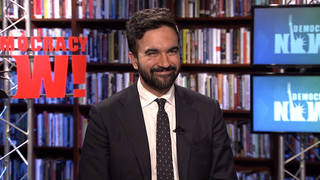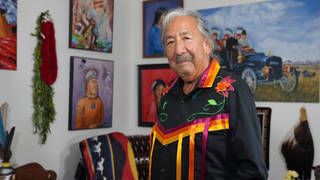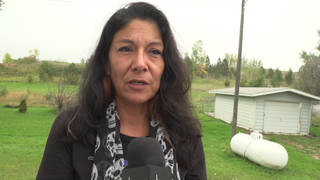
Guests
- Pieter Frankenco-founder of Safecast, a network of volunteers working to monitor radiation levels across Japan.
Safecast is a network of volunteers who came together to map radiation levels throughout Japan after the Fukushima Daiichi nuclear power plant disaster in 2011. They soon realized radiation readings varied widely, with some areas close to the disaster facing light contamination, depending on wind and geography, while others much further away showed higher readings. Safecast volunteers use Geiger counters and open-source software to measure the radiation, and then post the data online for anyone to access. Broadcasting from Tokyo, we are joined by Pieter Franken, co-founder of Safecast. “The first trip we made into Fukushima, it was an eye-opener. First of all, the radiation levels we encountered were way higher than what we had seen on television,” Franken says. “We decided to focus on measuring every single street as our goal in Safecast, so for the last three years we have been doing that, and this month we are passing the 15 millionth location we have measured, and basically every street in Japan has been at least measured once, if not many, many more times.”
Transcript
AMY GOODMAN: We’re joined right now by one of the founders of a network of volunteers who came together to map radiation levels throughout Japan after the Fukushima Daiichi meltdown in 2011. They soon realized radiation readings varied widely, with some areas close to the disaster facing light contamination, depending on wind and geography, while others much further away showed higher ratings. Safecast volunteers use Geiger counters and open-source software to measure the radiation, then post the data online for anyone to access. Their effort comes as Japan recently passed a new secrecy bill.
Well, for more, we’re joined by Pieter Franken, who is co-founder of Safecast.
Welcome Democracy Now! Explain what it is you’ve done. You’re turning smartphones into Geiger counters?
PIETER FRANKEN: Not really that simple. Actually, what happened is, after the disaster happened, we were all looking for information, and we couldn’t find any. And actually we tried to create a website where we could collect data and share it with people, so everybody could know what’s happening. And very quickly, we found out there was almost no data. The Japanese government had published nothing, and we were basically in the dark.
After we did that, we said, We’re not going to give up.” We had a plan to buy lots of Geiger counters, give it to lots of people, and basically use kind of crowdsourcing to get the data and then share the data. Unfortunately, in the first 24 hours after the disaster, almost any Geiger counter on the planet was sold out, so we couldn’t get all the equipment to do it.
So then we sat down and said, “How are we going to solve this problem? How do we get the data out?” Then, the idea was very simple. We decided to put a Geiger counter on a car, connected to a GPS and a computer, and start driving around and map the data—very much how Google maps streets. The whole idea was to do the same thing, but then for radiation. And that’s how we started.
AMY GOODMAN: And so, take it from there.
PIETER FRANKEN: And we took it from there. And then, the first trip we made into Fukushima, it was an eye-opener. First of all, the radiation levels we encountered were way higher than what we had seen on television. On top of that, we also noticed, as you mentioned, that the radiation is not very predictable. It’s not the distance to Daiichi that tells you how much radiation there is. It’s very blotchy. Nearby, we measured very high and very low. Much further away, we still were measuring high levels of radiation.
So, as we were talking to people, as we were meeting people, people started to say, like, you know, “We want to have data about where we’re living.” And the Japanese government was basically publishing averages for cities. But people are not an average. So, people are not living in the city hall; they’re living in the streets. So we decided to focus on measuring every single street as our goal in Safecast. So, for the last three years, we have been doing that. And this month, we are passing the 15 millionth location we have measured. And basically every street in Japan has been at least measured once, if not many, many more times.
AMY GOODMAN: What’s the gadget you’ve brought in here?
PIETER FRANKEN: Yes, let me show you this. This is the system that we’re currently using. We have a few hundred of these in use by our volunteers. And this is basically a Geiger counter that is in a waterproof and shock-proof case. And what happens is—the sensor is on the other side. What happens is this—
AMY GOODMAN: It’s about the size of a little transistor radio.
PIETER FRANKEN: Yes. It’s more or less. Yeah, it’s a very small, compact device.
AMY GOODMAN: It’s four inches by what? Five inches by three inches? Or—
PIETER FRANKEN: Somewhere around that, yes.
AMY GOODMAN: Yeah.
PIETER FRANKEN: And it is designed—the strap goes through the car window, and as you close the car window, the thing sits outside of the car. And basically, you have to just switch it on, and it automatically starts recording the level as you’re driving around. And we designed this with lots of volunteers over the last three years, and we’ve been through lots of iterations, and we now are able to give these to volunteers at a much lower cost. But more importantly, it is very easy to use. You don’t have to be a scientist to be able to collect this data.
AMY GOODMAN: How does the data go from the box to your company, Safecast?
PIETER FRANKEN: First of all, we’re not a company. We’re a volunteer organization. So, let me be clear about that.
How the data actually gets moved is very simple. It’s like a camera. It has an SD card. After you’re done, drive for a couple of hours, you take the SD card out, you go to our website, you upload the file, and then you can see a map of your radiation that you have measured. And then we merge that with our database, and then people can basically use an application that we—for example, on a smartphone, people can access—just a moment. They can then go to an application on an iPhone or an iPad. And I’ll try to kind of zoom in to where we are right now in Tokyo. And as we’re zooming in, I think you can see—
AMY GOODMAN: You’re making me very nervous.
PIETER FRANKEN: You can see every single street, and you can see all the measurements we have done around that.
AMY GOODMAN: And what are the measurements, for example? I mean, Tokyo is how many miles away from Fukushima?
PIETER FRANKEN: We’re about 200 kilometers away from Daiichi. As you can see on the map here, we’re here in Tokyo, and this is where Fukushima is. You can see there is a big difference in color.
AMY GOODMAN: Up north, the coast.
PIETER FRANKEN: Yes.
AMY GOODMAN: It’s around, what, 150 miles up the coast.
PIETER FRANKEN: Yes, yes.
AMY GOODMAN: And how toxic or radioactive is it here?
PIETER FRANKEN: Compared to the rest of Japan, Tokyo got a certain amount of fallout. Relatively speaking, I think the levels, what they are today are maybe 50 percent higher than what they were before the disaster. But compared to locations in Fukushima, it’s actually relatively low. So, in terms of, you know, exposure to radioactivity, this is nothing compared to what is happening in Fukushima prefecture and the areas around there.
AMY GOODMAN: And you’re taking this beyond the borders of Japan.
PIETER FRANKEN: Yes. Safecast started as a global organization. We got lots of help from outside of Japan. We would not have been able to do it without all the volunteers. And we got lots of people outside of Japan, had the same worry, and they started to worry about it, as well. And they’re using the same equipment now to measure their own environments. We have people measuring—lots of people measuring in the U.S. We have people measuring in Europe. We have some volunteers now in Africa. We have just covered all the seven continents in terms of having the first measurements in, and that is spreading very quickly right now.
AMY GOODMAN: And how has the map in Japan changed? We’re almost at the three-year mark, the third anniversary of Fukushima.
PIETER FRANKEN: Yes. If we look at radiation levels, specifically in Fukushima area, we see that the radiation levels have dropped by about 40 to 50 percent, depending on where and how you measure. And that is largely contributable to the half-life of some of the nucleates, and it is also contributable to the fact that the weather and the environment has specific ways of dealing with the material, and that has changed very slowly over time.
AMY GOODMAN: You’re also measuring air quality.
PIETER FRANKEN: Yes, we have started to—a project to measure air quality.
AMY GOODMAN: [inaudible] radiation.
PIETER FRANKEN: Yes, we got lots of interest in the radiation project, but lots of people came to us and said, “Please, can you do something about air quality?” And initially, we were too busy solving the problem of how do we measure radiation on a large scale. And we now have started to—a project to do that.
AMY GOODMAN: On the issue of the state secrets law, how does it affect you?
PIETER FRANKEN: We believe that it should not affect us. We are actually collecting facts and data about our environment, and we strongly feel that that data should be public and open, accessible.
AMY GOODMAN: And you’re saying you believe it shouldn’t?
PIETER FRANKEN: It should, yes. That’s our belief.
AMY GOODMAN: Are you concerned that it will?
PIETER FRANKEN: I’m personally not concerned about it, because I believe that that should not be an issue. However, how that will be reacted upon is something that we have to go and see. We don’t know at this point.
AMY GOODMAN: Shouldn’t the government be collecting this data and sharing it with the citizens of this country?
PIETER FRANKEN: Yes, absolutely. In the beginning of the disaster, the data that was made available by the government was almost nothing. I think through, you know, projects like Safecast, there has been lots of pressure to do more. The Japanese government has been publishing more, TEPCO has been publishing more, undoubtedly because there has been external pressure. However, the problem we have with some of the data collection is it is very selective. And the other problem is, lots of the data is available, but it is not open. So, it is copyright-protected. You can’t download it and do something with it. It is restricted.
AMY GOODMAN: The Japanese government says don’t trust the information you have, that it’s very important to rely only on government readings.
PIETER FRANKEN: We strongly believe that in order to have credibility, you need to check your data. And we, in Safecast, our goal is to independently measure, as citizens, if the data is correct or not.
AMY GOODMAN: And the response of the corporation, TEPCO, the Tokyo Electric Power Company, that runs the, owns the nuclear power plants, to what you’re doing?
PIETER FRANKEN: We have never been contacted by TEPCO, so I can’t really give a good answer to that question.
AMY GOODMAN: Well, I want to thank you very much for being with us. If people want to find out more information about this Safecast Geiger counter?
PIETER FRANKEN: Yes, yes. We have a website, Safecast.org. If you go to our website, you can find more information about what we’re doing, and also how you can build this device yourself and how you can participate in the Safecast project.
AMY GOODMAN: In the global mapping of radiation and air quality.
PIETER FRANKEN: Yes. Anybody anywhere can participate. It’s really easy.
AMY GOODMAN: Pieter Franken, thanks so much for being with us, co-founder of Safecast.
And that does it for our three broadcasts from Tokyo, Japan. I’ll be speaking Saturday, January 18th, here in Tokyo at Sophia University at 10:00 a.m. at the International Conference Room, 17th floor, No. 2 Building. Then on Sunday, the 19th of January at 7:00 p.m., I’ll be speaking in Kyoto at the Kyoto Kyoiku Bunka Center. That’s the Kyoto Education Culture Center. On Monday, we’ll be back here in Tokyo. That’s January 20th. And I’ll be speaking at the Foreign Correspondents Club of Japan, the FCCJ, for a noon talk. You can check our website at democracynow.org for all the details of these three days of talks. Then we’ll be headed to the Sundance Film Festival in Park City, Utah, where we’ll be broadcasting after the Martin Luther King holiday, Tuesday to Friday.












Media Options